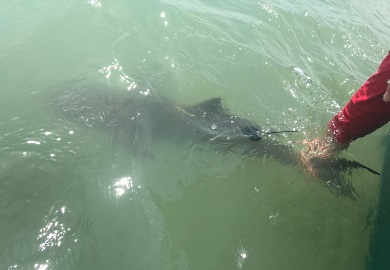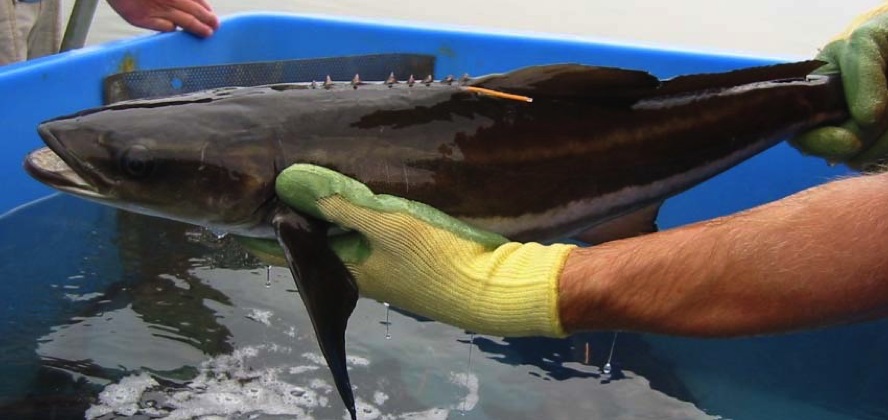April 22, 2019

After being satellite tagged, a cobia is returned to the water (Photo: Eric Reyier/Kennedy Space Center Ecological Program)
New research led by the South Carolina Department of Natural Resources (SCDNR) aims to better determine where and when cobia migrate across southeastern coastal waters, and biologists are asking for the help of saltwater anglers.
Cobia are large, streamlined fish that swim great distances along the Atlantic and Gulf coasts – but the boundaries of their different populations, or stocks, are not fully understood. By using satellite and acoustic tags to track the movements of individual cobia, biologists hope to learn more about the migratory patterns of these commercially and recreationally important fish.
For this project, biologists in North Carolina, South Carolina, Georgia and Florida will be tagging 27 cobia with both pop-up satellite archival tags (PSATs) and acoustic transmitters.
“The satellite tags will record information about each fish’s movements, including depth, water temperature, and location,” said SCDNR biologist Matt Perkinson, co-principal investigator on the project. The acoustic transmitters will provide additional location information by emitting a “ping” that is recorded when the cobia travel within 1/4 mile of an extensive network of listening devices maintained throughout the region. “The combination of tag types will allow us to follow cobia movements when they’re relatively close to shore, where the listening devices are mostly stationed, as well as in Gulf Stream waters.”
An additional 20 cobia will also be tagged with just acoustic transmitters in an effort to build on the results of a previous cobia-tagging project. All project fish will also receive an orange streamer-type tag with a alphanumeric code beginning with the letter “M.”

Cobia grow to be large, dark brown or gray fish with white undersides that somewhat resemble sharks (Photo: Al Stokes/SCDNR)
Tagging fish across the southeastern coast requires a team effort, and partners on this project include staff from the Florida Fish and Wildlife Conservation Commission (FWC), Kennedy Space Center Ecological Program, the Georgia Department of Natural Resources and the North Carolina Division of Marine Fisheries. Funding comes from the NOAA Cooperative Research Program.
What if I Catch a Tagged Cobia?
Anglers that encounter one of these tagged cobia are asked to please use a net or lip gripping device to land the fish – and then release them if possible. Each of these fish is contributing information critical to the future of healthy, sustainable cobia populations. If you do accidentally harvest one of these fish, please save the acoustic transmitter located in the body cavity on the underside of the fish along with the satellite tag and contact project biologist Justin Yost at (843) 953-2011 or YostJ@dnr.sc.gov.



